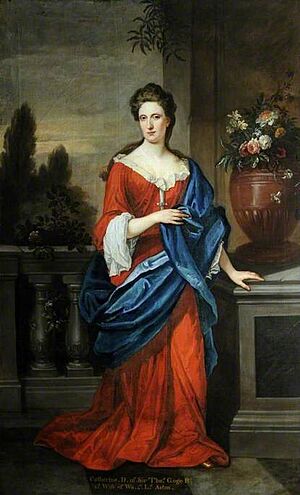Walter Aston, 3rd Lord Aston of Forfar facts for kids
Walter Aston, 3rd Lord Aston of Forfar (born 1633 – died 1714) was an important figure in English history. He was the oldest son of Walter Aston, 2nd Lord Aston of Forfar, and his mother was Lady Mary Weston. He is mostly remembered today because he survived a dangerous time known as the Popish Plot.
Walter Aston became the Lord Aston of Forfar in 1678, inheriting a special title from Scotland. He lived mainly at Tixall in Staffordshire, England. He also owned land at Standon in Hertfordshire, which his family received from their relatives, the Sadlers.
Family Life
Walter Aston was married two times. His first wife was Eleanor Blount Knightley. She was from Worcestershire, England. Eleanor was the daughter of Sir Walter Blount, 1st Baronet. She passed away in 1674. They had five children who grew up.
Later, he married Catherine Gage. She was the daughter of Sir Thomas Gage from Firle in Sussex. Catherine passed away in 1720.
Walter and Eleanor had four sons who lived to be adults: Edward, Francis, Walter, and Charles. They also had one daughter named Mary, who never married. Edward and Francis died before their father. This meant that Walter, his third son, became the 4th Lord Aston after his father passed away.
The Popish Plot
Like his father, Walter Aston was a strong Roman Catholic. He became the unofficial leader of the large Catholic community in Staffordshire. Because of this, he became a main target for people who spread false information during the Popish Plot.
His former employee, Stephen Dugdale, had been fired for stealing money. Dugdale then falsely accused Lord Aston and his brother William. In 1679, they were sent to the Tower of London. They were accused of planning to kill King Charles II.
Dugdale was a convincing speaker. He made a different impression on the government than other accusers, who were known criminals. Even King Charles II, who did not believe the plot at first, started to think Dugdale's story might be true.
However, the law required two witnesses to prove treason. Even when people were very scared about the plot, the judges followed this rule carefully. It was impossible to find a second witness against Lord Aston. He was never put on trial. He was released from prison in the summer of 1680 and never had to go back.
Later Years
When the Catholic King James II was in power, Walter Aston was well-liked at the court. He served as the Lord Lieutenant of Staffordshire from 1687 to 1689. This was an important role, representing the King in the county.
After the Glorious Revolution, when James II lost his throne, Walter Aston remained loyal to him. However, no action was taken against Lord Aston. In his final years, he felt secure enough to complain about being excluded from the House of Lords. This was because of his Catholic faith.
He argued that since his title was a Scottish title, he should be one of the Scottish representative peers. These peers were allowed to sit in the unified House of Lords after the Act of Union 1707. However, his request to join the Lords was not accepted.
Walter Aston passed away in 1714. His third son, Walter Aston, 4th Lord Aston of Forfar, inherited his title. Another younger son, Charles Aston, served in the British Army in Ireland. He was killed in battle at the Battle of the Boyne on July 1, 1690.


